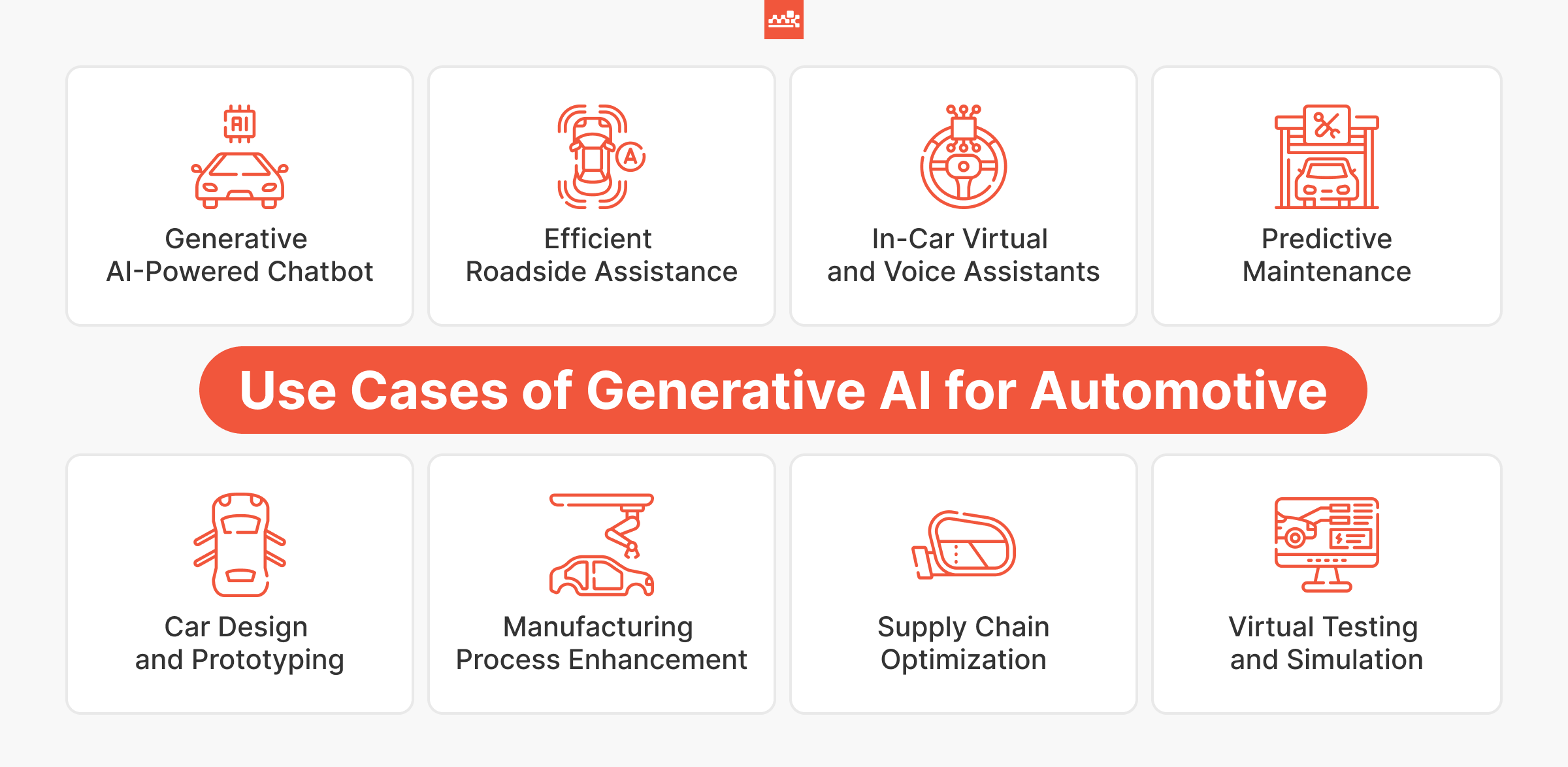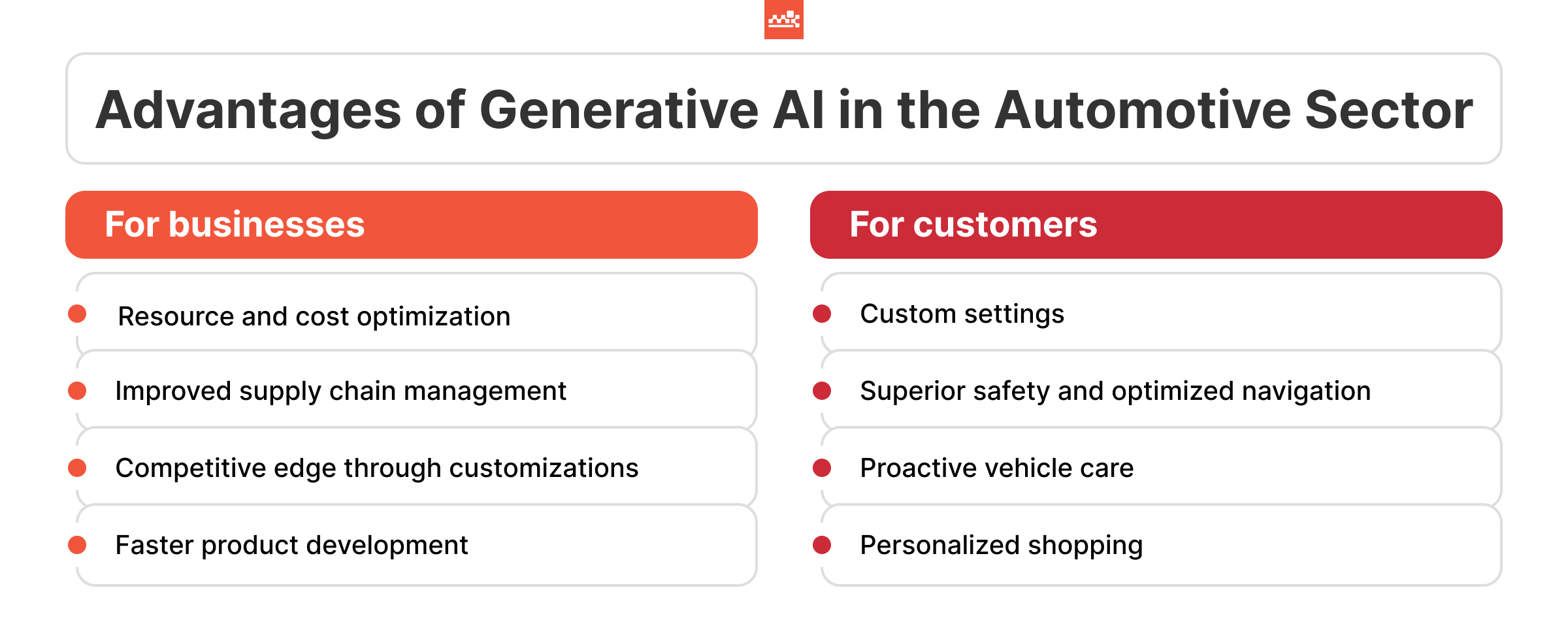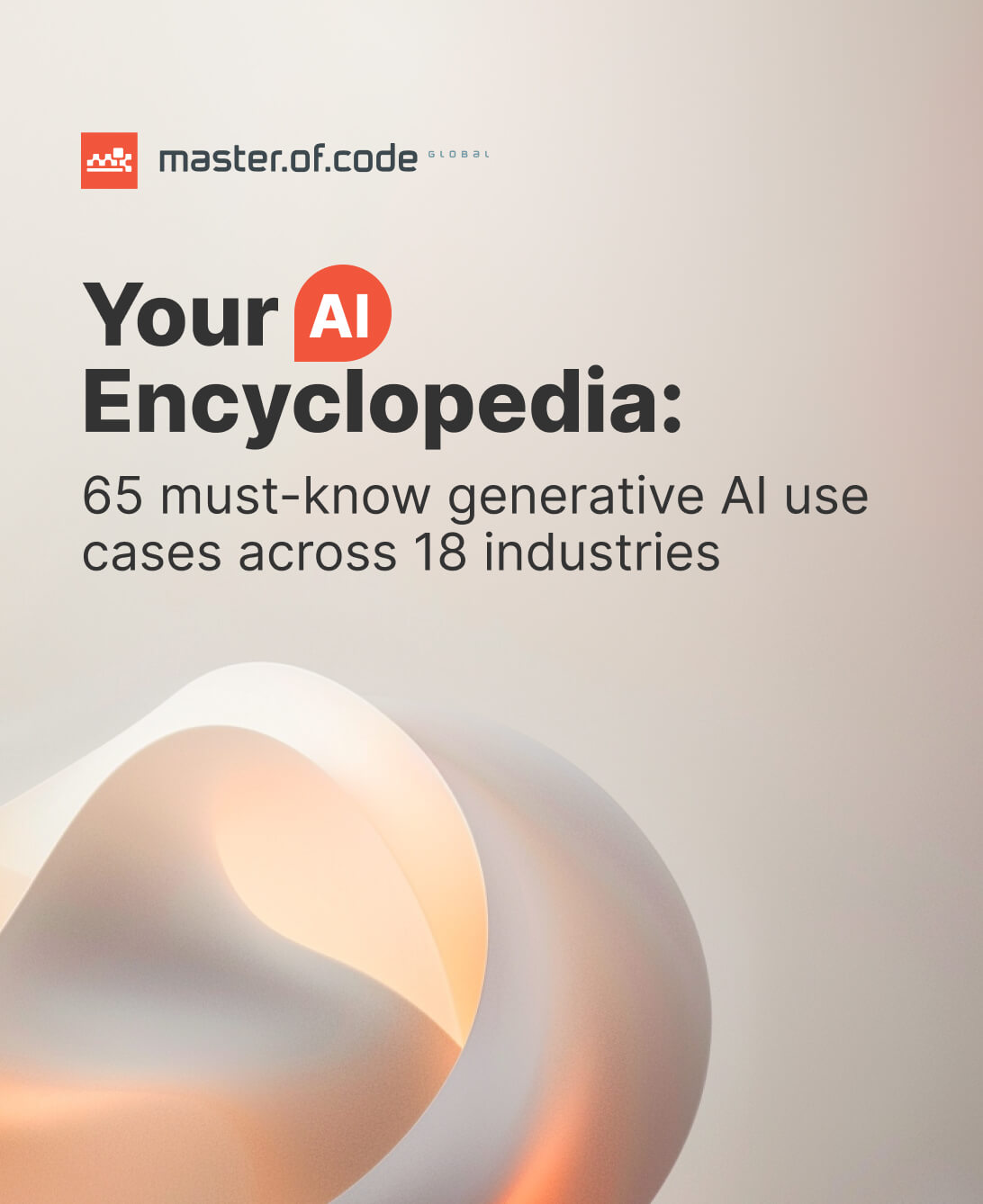Day by day, the automotive industry is transforming with advancements like electric vehicles and autonomous driving, creating a demand for more sophisticated systems. So, Gen AI is rapidly becoming a core tool for navigating the new challenges and opportunities.
In fact, Artificial Intelligence is already making a noticeable impact on automotive businesses. McKinsey reports that its implementation could lead to a 10–20% reduction in development timelines for automobile parts. The application of Generative AI in automotive has wide-ranging implications. It offers significant improvements in efficiency, innovation, customization, and customer experience (CX).
Let’s explore some of the potential Generative AI use cases and their benefits in more detail.
Table of Contents
Figures Don’t Lie: The Rise of Generative AI in Automotive

A study by IDC and Microsoft shows that 71% of organizations currently use Artificial Intelligence. An additional 22% plan to implement it within the next year. This adoption is leading to major business improvements. Companies report an 18% increase in customer satisfaction and employee productivity. Financially, the result is also impressive: for every dollar invested in AI, businesses are witnessing an average return of $3.5 (350%), showcasing the technology’s remarkable ROI potential.
The market for Artificial Intelligence in the auto sector, valued at $312.46 million in 2022, is forecasted to soar to nearly $2.7 billion by 2032, and McKinsey estimates the technology will create $300 billion in annual value by 2035.
The industry’s commitment to this technology is evident from executive-level discussions to operational implementation. A survey by Capgemini reveals that 94% of executives in this field discuss the new technology at board meetings. More than half, 51%, strongly advocate for its use. A majority, 66%, believe that the benefits of artificial intelligence outweigh the risks.
On the operational side, 30% of organizations have dedicated teams for AI integration. They are incorporating it into product development, showing how important it is for the industry’s future.
How Generative AI is Used in Automotive
From the customer showroom to the factory floor, Artificial Intelligence is delivering measurable business growth. We know this because we’ve seen its impact firsthand, helping clients boost lead conversion by 37% with a hands-free AI Voice Agent, scale a Car Dealership Chatbot to 195 locations, and cut a manufacturer’s operational costs by 45% using Predictive Maintenance. It’s these experiences that inspired us to break down the specific use cases that are delivering significant returns, not in the distant future, but today.
Design and Engineering
Think of AI as a creative partner for both creative and tech specialists. You give it the rules, like weight and material, and it comes up with thousands of smart designs to get you started. This process, known as topology optimization, helps create parts that are lighter, stronger, and more cost-effective than what could be achieved through traditional methods alone. Generative AI dramatically speeds up prototyping by turning rough sketches into polished, aerodynamic 3D models and simulating their performance virtually.
Manufacturing
On the factory floor, the technology is streamlining production and enhancing quality control. By analyzing sensor data from the assembly line, AI-powered computer vision can detect defects or inconsistencies that might be missed by the human eye. It also plays a crucial role in optimizing the supply chain by forecasting demand, identifying potential disruptions, and managing inventory more precisely. This leads to reduced waste, lower costs, and a more resilient manufacturing process.
Software and Simulation
With vehicles becoming more like computers on wheels, software development is a critical area of focus. A McKinsey report found that AI can cut time spent on coding tasks by up to 40% by helping developers write, translate, and document code more efficiently. Beyond coding, the technology creates highly detailed digital twins, virtual replicas of a vehicle, that can be used for extensive testing. Engineers can simulate thousands of scenarios, from crash tests to extreme weather conditions, reducing the reliance on costly and time-consuming physical prototypes.
Customer Experience
For car buyers, AI-powered chatbots can answer questions, provide financing options, and schedule test drives 24/7. Inside the vehicle, the technology enhances the driving experience itself. Smart assistants learn a driver’s preferences to adjust routes, climate control, and entertainment automatically. For example, Mercedes-Benz has integrated ChatGPT into over 900,000 vehicles to offer more advanced and personalized voice interactions.
Safety and Development
Artificial intelligence is fundamental to the improvement of safety systems, particularly Advanced Driver Assistance Systems (ADAS). By training on vast datasets of road imagery, smart models learn to accurately detect and track pedestrians, vehicles, and traffic signs in real-time.
This capability powers features like automatic emergency braking and lane-keeping assist. It also enables predictive maintenance, where the system monitors vehicle data to alert the driver about a potential part failure before it happens, preventing breakdowns and improving long-term reliability.
Impactful Generative AI Use Cases in the Automotive Industry

When most people hear ‘AI and cars,’ they immediately think of self-driving technology or robots on the factory floor. But that’s only part of the story. A newer, more creative form – Gen AI – is making its impact felt long before the rubber meets the road.
This technology is being used not just to operate vehicles, but to fundamentally reimagine how they are designed, marketed, and sold. Here are some of the most impactful applications right now.
Customer Experience & Engagement
GenAI Chatbots for Repair & Maintenance Services and Dealerships
Automotive chatbots answer complex queries on vehicle specifications, pricing, and availability, making it easier and faster for you to decide. Skilled in addressing technical queries, automotive virtual assistants (VAs) elevate the standard of after-sales support, ensuring customer loyalty.
For instance, our team developed an Artificial Intelligence Voice Agent for a major automotive group to solve these very challenges. By handling initial inquiries and scheduling test drives around the clock, the solution delivered a 37% increase in lead conversion rates and a 26% growth in test drive appointments. The same technology seamlessly manages service appointments and sends personalized maintenance reminders based on mileage and vehicle history, boosting customer loyalty long after a sale is complete.
Generative AI-Powered Chatbots and Voice Assistants
The autonomous agents make it easy to do things like set up navigation, play music, or send messages using just our voice. This means drivers can stay focused on the road without getting distracted by buttons or screens. They can simply say, “I’m feeling cold,” and the technology will know to raise the cabin temperature, rather than requiring a rigid command like “Set temperature to 72 degrees.”
For automakers, AI is a key differentiator, making vehicles more appealing to tech-savvy customers. Plus, they open up new ways for drivers to shop or find services while they’re on the road, like ordering food or finding parking.
Voicebot in car is also quickly becoming a must-have feature. A study involving 1,008 regular drivers found that about 50% are interested in adding AI capabilities to their in-car voice assistants. This interest jumps to 75% among those who frequently use vehicle assistance. Even among drivers who rarely use them, around 28% are open to adopting these advanced features.

Among other Gen AI use cases in automotive industry, VAs are easy for anyone to use because these AI systems understand normal speech. They can give you traffic updates, suggest different routes, or remind you about appointments as you drive. For auto makers, this is a great chance to learn more about what drivers like and how they use their automobiles. They can use this information to build better cars and offer services that really fit what drivers need.
These assistants can also integrate with other services to perform complex tasks. For example, a driver can ask the assistant to find and pay for a parking spot near their destination or even order their regular coffee from a nearby café so it’s ready for pickup. This turns the vehicle into a true personal assistant, simplifying daily tasks.
AI-Driven Customer Experience Personalization
AI in automotive industry allows you to create a truly individualised journey for every customer. The system builds a detailed profile based on each person’s interactions, such as the pages they view on your website, the vehicles they configure, and the questions they ask the chatbot. This data allows for hyper-targeted communication.
Imagine a customer who has been browsing family-sized SUVs. The AI can automatically send them a personalized email highlighting the safety features of a new model or an exclusive financing offer. When a car company gets this right, you feel like they actually get you, which is why you’d stick with them for your next car.
Virtual Showrooms and Immersive Car-Buying Experiences
Why limit customers to static photos online? Implementing this new technology can help create dynamic, virtual showrooms where buyers can explore a vehicle from the comfort of their home.
They can “sit” in the driver’s seat for a 360-degree interior view, click on the infotainment screen to see a demo of its features, and experiment with different color combinations and interior finishes. This immersive experience makes the car feel more tangible and helps buyers make confident decisions before ever stepping into a dealership.
Simplified Manuals and Efficient Roadside Assistance
Generative AI in the automotive industry is making a big impact on how this works. Now, AI-enhanced guides are more than just books; they’re interactive assistants. They can understand specific questions and offer precise, car-specific advice.
This is not only more efficient for drivers but also cuts costs for businesses. A vehicle assistant reduces the need for customer service staff and increases happiness rates as users get quick, personalized help. Roadside support is also getting a boost.
Virtual assistants powered by AI can quickly figure out what’s wrong with a car by analyzing the data or listening to the driver’s description. This leads to faster and more accurate help. It’s a big win for auto enterprises, especially those managing fleets of vehicles.
It’s about building a brand that customers trust and prefer, thanks to the improved service and engagement that AI car assistants bring to this experience.
Vehicle Design & Manufacturing
Car Design and Prototyping
Generative AI for engineering and manufacturing teams allows designers to experiment with countless shapes and features quickly, allowing them to be more creative and come up with innovative approaches and efficient samples. As a result, it helps speed up the development process and complete more taste in less time.
In prototyping, the role of automotive Generative AI is in simulating how a design performs under various conditions, reducing the need for physical prototypes. With AI, you get more productive R&D processes, ensuring that new vehicle types are both innovative and reliable.
Virtual Testing and Simulation
Using Generative AI for simulation and testing allows engineers to identify potential issues and opportunities for improvement and test numerous scenarios quickly and safely, from crash simulations to performance in different weather conditions.
Artificial Intelligence also plays a key role in simulating consumer experiences because it models how drivers and passengers interact with the vehicle, from the comfort of the seats to the ease of using the infotainment system. Consequently, companies can see how the final product performs and offers a superior driving experience for customers.
Manufacturing Process and Quality Control Enhancement
In the factory, Artificial Intelligence optimizes production lines for maximum efficiency and quality. It can analyze acoustic and thermal data from machinery to predict when a part might fail, allowing for maintenance before a breakdown occurs. For quality control, vision systems and Gen AI-powered virtual agents inspect parts with superhuman precision. They can detect microscopic defects in paint finish, verify the integrity of every weld, and make sure that all components are assembled perfectly, leading to higher quality vehicles and fewer recalls.
Operations & Supply Chain
Supply Chain Optimization
AI use cases in automotive industry also cover real-time tracking and management of materials, components, and finished products. This advanced tracking system ensures that the right parts are available at the proper time, reducing delays in manufacturing, leading to smoother operations and lower inventory costs.
Furthermore, AI helps with forecasting and planning within the logistics network. It analyzes patterns in supply and demand, anticipating future needs more accurately. This predictive capability allows enterprises to optimize their procurement and distribution strategies, avoiding both shortages and surpluses.
Integration of AI with Dealership DMS/Workflow Systems
The real power of AI is unlocked when you embed Generative AI into automotive workflows and connect it to your core operating systems. When the AI handles routine tasks like lead qualification and appointment booking, it frees up your team to focus on high-value interactions. A salesperson can receive a notification that a high-intent buyer is on the lot and instantly pull up their entire history, allowing for a highly informed and personal conversation.
Vehicle Performance & Maintenance
Predictive Maintenance
What if your car could tell you a part was going to fail before you were stranded on the side of the road? That’s the idea behind predictive maintenance. The Gen AI-enabled agents alert you to get a part checked out before it becomes a real problem.
Generative AI also helps with managing car fleets. It tracks each vehicle’s condition, planning maintenance before issues arise. This reduces downtime and maintains fleets on the road longer, saving money and time for businesses, as they can avoid unexpected repairs and plan better.
AI-Enhanced Battery Management Systems for EVs
For the EV driver, battery health is everything. AI acts like a smart battery coach, analyzing your charging habits and driving patterns to get the most range out of every charge and help the battery last longer. This improves the daily driving experience and extends the lifespan of the battery pack, protecting the owner’s investment.
Autonomous Driving Advancements
Artificial intelligence is also essential for training the next generation of autonomous vehicles safely and effectively. It creates highly realistic virtual environments where self-driving models can practice navigating millions of miles and encounter rare but critical “edge cases,” like a deer crossing a foggy road at night. By exposing the car assistant to a massive variety of challenging scenarios in a simulation, developers can make autonomous systems far more reliable and capable in the real world.
Insurance
Generative AI is making car insurance fairer and more personalized. By analyzing real-time data from an automobile’s telematics, AI can assess actual driving habits, such as braking, speed, and cornering. This allows insurance companies to offer usage-based policies, rewarding safe drivers with lower premiums that accurately reflect their risk on the road.
After an accident, a driver can simply upload photos of the damage through a mobile app. A Generative AI model then analyzes the images to instantly assess the extent of the damage, estimate repair costs, and even flag potential fraud. This can reduce a claims process that used to take weeks down to just a few minutes, getting you back on the road sooner.
Case Studies
Car Dealership Chatbot
Master of Code Global supercharged the automobile shopping experience with a GenAI-powered virtual assistant built for scale – 195 dealerships, 14 car brands, and 79 model variations, all covered. This unauthenticated web messaging solution features an intelligent FAQ bot that instantly tackles even the trickiest customer questions. With seamless routing and deeply personalized responses, it transforms static website visits into dynamic, high-impact interactions that drive engagement and make finding the perfect vehicle feel effortless.
AI Voice Agent for Dealerships
One of the most popular AI use cases in automotive industry was also covered in our recent case study. Master of Code Global tackled lead conversion and customer retention challenges for a major automotive group by developing a hands-free AI voice agent. Integrated across their mobile app, website, and WhatsApp, the omnichannel solution engages customers on their preferred channel 24/7. The agent uses advanced NLP to capture leads, automate test-drive bookings, and deliver personalized after-sales support. This resulted in a seamless customer journey that drove a 37% increase in lead conversion and a 26% growth in test-drive appointments.
Predictive Maintenance for Manufacturing
Master of Code Global transformed operations for a major automotive parts manufacturer that was losing millions to equipment failures by building a smart predictive maintenance platform. Deployed across 12 manufacturing facilities, the system monitors thousands of sensors on CNC machines and assembly lines. It analyzes real-time data to identify degradation patterns, predict failures, and automatically schedule repairs in their existing SAP system. This proactive approach cut unplanned downtime by 67% and reduced overall maintenance costs by 45%.
Benefits of AI in Automotive Industry
The impact of innovation in this sector isn’t a one-way street. The same technological advancements that create massive efficiencies on the factory floor are also delivering safer, smarter, and more tailored experiences inside the car.
It’s a rare win-win that benefits both the companies building the vehicles and the people who drive them. Let’s break down the key advantages for each.

For Businesses:
Efficiency Gains
Generative AI can streamline manufacturing processes. It optimizes production lines and powers predictive maintenance. It also accelerates product development by automating parts of the design and simulation process, allowing you to bring innovative vehicles to market faster.
Predictive Insights
Generative AI for automotive gives you the ability to anticipate future needs with remarkable precision. It analyzes market data to forecast sales trends, monitors logistics networks to predict supply chain disruptions, and tracks equipment health to schedule repairs before a failure occurs. Our predictive maintenance solutions, for example, have achieved a 92% accuracy rate in forecasting equipment issues, giving businesses the foresight to act timely. This is often delivered through AI-generated dashboards and analytics summaries that make complex data easy to understand.
Enhanced Quality Control
By using AI-powered vision systems on the assembly line, manufacturers can detect microscopic defects in parts or paintwork that are invisible to the human eye. This automated quality control ensures every vehicle meets the highest standards, leading to fewer recalls, lower warranty costs, and a stronger brand reputation for reliability and excellence.
Customer Engagement
AI-powered assistants are always on, ready to engage customers 24/7. They can answer questions, qualify leads, and schedule test drives, ensuring you never miss an opportunity. As we saw with a major automotive group, implementing an AI Voice Agent can increase lead conversion rates by 37%. This technology allows you to build stronger customer relationships at scale.
Innovation Leadership
Generative AI in automotive enables you to develop next-generation features, from smarter in-car assistants to more advanced safety systems. By embracing this technology, you can outpace competitors, meet the evolving expectations of tech-savvy consumers, and establish your brand as a leader in automotive innovation.
For Consumers:
Personalized Experiences
Artificial Intelligence tailors the entire automobile ownership experience to you. Inside the vehicle, it learns your preferences for seating, climate, and music to create the perfect driving environment. During the buying process, it provides personalized vehicle recommendations and financing options that fit your specific needs, making the journey feel effortless and unique.
Improved Safety
AI in automotive acts as an intelligent co-pilot, making driving significantly safer. It powers Advanced Driver Assistance Systems (ADAS) that can detect pedestrians, monitor blind spots, and even apply the brakes automatically to prevent a collision. By constantly analyzing the road and the vehicle’s surroundings, AI helps protect you and your passengers from potential hazards.
Convenience
From simplifying daily tasks to providing instant support, AI makes car ownership more convenient. Hands-free voice assistants allow you to set navigation, send messages, or find parking without taking your eyes off the road. Interactive digital manuals provide immediate answers to your questions, while automated reminders make sure you never miss a scheduled service appointment.
Sustainability
Generative AI in automotive contributes to a greener future for the industry by optimizing battery performance to extend range and prolong battery life. Moreover, AI-powered navigation systems find the most fuel-efficient routes to reduce emissions. And in the design phase, smart solutions help create lighter, more aerodynamic automobiles that consume less energy.
Challenges of AI in the Automotive Industry
High Implementation Costs
Bringing AI technology into the automotive world requires a substantial upfront investment. This goes far beyond just software licenses. It includes spending on high-performance computing infrastructure, scalable cloud or on-premise data storage, and advanced networking capabilities. The significant initial cost and the fact that a return on investment is not always immediate can make it challenging to secure the necessary budget.
Data Privacy & Security Risks
Connected vehicles generate vast amounts of sensitive data, from driver location and habits to personal information linked to in-car accounts. This data is a valuable target for cyberattacks. Ensuring robust security to protect this information is critical for maintaining customer trust and preventing breaches. Companies must also navigate a complex web of data protection regulations, like GDPR, which impose strict rules on how customer data is collected, stored, and used.
Integration Complexity
AI in automotive systems cannot simply be plugged into existing automotive frameworks. There is a fundamental challenge in merging the fast-paced, iterative nature of AI development with the traditional, more rigid V-model lifecycle used in automotive engineering. Furthermore, critical data is often trapped in different departmental “silos” on legacy systems. Integrating these fragmented data sources to train effective AI models is a major technical and organizational hurdle.
Regulatory Uncertainty
The rulebook for AI in vehicles, especially for autonomous driving, is still being written. Governments and international bodies are working to establish clear standards, but there is currently a lack of a unified global framework. This creates uncertainty around crucial issues like liability. For example, who is at fault when an autonomous car is involved in an accident? Navigating this evolving legal and regulatory landscape is a significant challenge.
Talent Shortage
Successfully developing and deploying Generative AI in the automotive industry requires a specialized skill set. There is a high demand for data scientists, machine learning engineers, and AI specialists who also have a deep understanding of automotive systems. This specific combination of expertise is rare, leading to fierce competition for talent. Companies must either invest heavily in recruiting from a limited pool of experts or commit to extensive upskilling programs for their existing workforce.
Model Transparency
Many of the most powerful Generative AI in automotive industry models, particularly in deep learning, can operate like a “black box.” In an industry where safety is paramount, this lack of transparency is a major concern. Engineers and regulators need to be able to verify and validate the reasoning behind every action an AI-powered vehicle takes, which is a significant challenge with opaque models.
Top 5 Automotive Companies Using Generative AI
Mercedes-Benz
Mercedes-Benz has integrated ChatGPT into over 900,000 vehicles in a beta program. This technology powers the VAs, offering an advanced level of interaction and customization for drivers. AI in automotive companies enables a more intuitive user engagement with automobile functions through natural language processing capabilities. This is a huge step forward for the in-car experience. Artificial intelligence can transform traditional vehicle interfaces into more responsive, user-friendly systems.
Toyota
Among automotive companies using Gen AI, Toyota’s Research Institute is using it in designing new electric vehicles (EVs). Their novel tool aids designers by converting text prompts like “sleek” and “SUV-like” into initial prototype sketches. This approach significantly streamlines the creative process, reducing the number of iterations needed to refine a design. The technology considers key engineering constraints such as aerodynamics and cabin size. This way, the instrument ensures that the designs are aesthetically pleasing and functionally viable.
CarMax
CarMax is using GPT-3.5 to improve its business and customer service. Working with Microsoft and OpenAI, the company has automated the writing of descriptions for its used car inventory. Integrating Generative AI into dealership workflow systems has led to increased web traffic and improved SEO rankings. The AI-driven content creation significantly cuts down on the resources typically needed for manual copywriting. Additionally, this technology has been instrumental in optimizing the retailer’s digital marketing efforts, making their online listings more attractive and accessible to potential buyers.
BMW
BMW is developing a new driver assistance system for its 2025 “Neue Klasse” vehicles using Amazon Web Services (AWS). This project will use AWS for cloud-based innovations, including AI. The company’s existing Cloud Data Hub on AWS will be a key part of this feature, focusing on improving vehicle safety and features.
By combining AWS’s computing power with AI, the manufacturer aims to create advanced, efficient driving aids. This partnership shows BMW’s commitment to using the latest technology for better, safer cars. The use of AWS and Artificial Intelligence is a big step towards more intelligent automobiles in the future.
CarGurus
CarGurus has improved its online car shopping with a new feature called the CarGurus ChatGPT plugin. This tool uses Gen AI to help make finding a vehicle easier and more personal on the top online car platform in the US. Users can now use conversational prompts, ranging from broad to specific, to find their ideal automobile. This plugin is a significant advancement in how potential buyers can navigate extensive vehicle listings. Moreover, it allows for more tailored searches beyond fixed criteria.
Best Practices for Implementing Generative AI in the Auto Industry
Start with Clear, High-Impact Use Cases
Don’t try to solve every problem at once. The best approach is to begin with a specific, high-value business challenge where AI can make a significant and measurable impact. This could be automating lead qualification to boost sales or implementing predictive maintenance to cut operational costs. Starting with a strategic Proof of Concept (POC), like those our team helps clients develop, allows you to demonstrate value quickly and build momentum for broader adoption.
Embed Gen AI Across the Software Lifecycle
AI for automotive should not be an afterthought bolted on at the end of a project. To get the most value, embed these tools across the entire software development lifecycle. Use AI to help draft initial requirements, design system architecture, accelerate code generation and review, and even automate the creation of technical documentation. This integrated approach improves speed, quality, and consistency from start to finish.
Build a Strong Foundation of Data and Technical Infrastructure
The performance of any AI model is directly tied to the quality of the information it’s trained on. This means you must prioritize creating a data foundation by breaking down internal silos and ensuring your information is clean, organized, and accessible. This effort needs to be supported by a robust technical infrastructure, including scalable cloud storage.
Adapt Operating Models and Upskill Teams
Successfully implementing Gen AI–driven operating models requires more than just technology; your people and processes must evolve as well. It’s essential to invest in training programs to empower your current teams, from engineers to product managers, to use these tools effectively and responsibly. Fostering a culture of collaboration and agility is also key, as it encourages your organization to embrace these new ways of working.
Improve Safety, Compliance, and Human Oversight
In an industry where safety is non-negotiable, AI cannot operate in a vacuum. It is critical to implement a “human-in-the-loop” system, where human experts review and validate the outputs of AI, especially in safety-critical applications like driver assistance systems. All AI development must be aligned with strict industry regulations and safety standards.
Use a Modular, Cloud-Native Architecture
A modular design, like working with building blocks, makes your Generative AI in automotive systems more flexible and easier to update or integrate with other tools. A cloud-native approach ensures your solutions are scalable, meaning they can handle growing volumes of data and users without performance issues, effectively future-proofing your investment.
Monitor Performance Metrics and Iterate
Implementing AI is an ongoing process, not a one-time project. Before you begin, define what success looks like by establishing clear Key Performance Indicators (KPIs). These could include metrics like time saved on code documentation, the accuracy of sales forecasts, or a reduction in customer service tickets. By continuously monitoring these metrics, your team can refine the models over time, ensuring they deliver increasing value to the business.
New Automotive Trends with Gen AI
- Customized infotainment systems. AI employs voice recognition to personalize interactions and commands. The system also learns from user choices, suggesting relevant content. These capabilities collectively create a more intuitive and enjoyable in-car experience.
- Enhanced urban mobility. AI efficiently manages traffic flow by predicting congestion and optimizing public transport schedules. It alleviates urban crowding by analyzing real-time traffic information. This advancement similarly improves personalized routing in ride-sharing services, making travel more efficient.
- Self-driving technology. Gen AI analyzes extensive sensor data to enable safe autonomous driving. It is capable of learning from diverse environments and adapting its responses. It anticipates road hazards and reacts appropriately. These systems are perpetually evolving, ensuring safer driving automation.
- Improved fuel efficiency and reduced emissions. Artificial Intelligence adjusts engine performance for optimal fuel use. The algorithms adapt to changing driving conditions in real-time. They also help in reducing emissions by improving combustion processes. Additionally, AI-driven route optimization contributes to lower fuel consumption overall.
FAQ about Gen AI Use Cases in the Automotive Industry
1. How is AI transforming automotive design and prototyping?
The use of Generative AI in automotive dramatically accelerates the design process. Engineers can input specific constraints like weight, materials, and desired performance, and an AI model will produce thousands of optimized design options in a fraction of the time. It also allows for extensive virtual testing and simulation, which helps identify potential flaws early and reduces the need for costly and time-consuming physical prototypes. This leads to more innovative, efficient, and reliable vehicles being developed faster.
2. What role does Generative AI in the automotive industry play in predictive vehicle maintenance?
AI is a game-changer for maintenance, shifting the approach from reactive to proactive. It analyzes real-time data from sensors across a vehicle or on a factory floor to detect subtle patterns that indicate a component is likely to fail. By predicting issues before they happen, AI allows for maintenance to be scheduled during planned downtime. Our team’s work in this area has helped clients achieve a 92% accuracy rate in predicting failures, preventing costly breakdowns, and improving overall reliability.
3. Can AI improve customer engagement in the automotive sector?
Absolutely. AI-powered virtual assistants and chatbots provide instant, 24/7 support to your clients. They can answer complex questions, schedule test drives, and manage service appointments, ensuring no lead is ever lost. More importantly, AI personalizes the entire journey by offering tailored vehicle recommendations and support based on a customer’s unique needs. This level of service directly impacts business growth; for example, our Voice Agent solution helped one automotive group increase its lead conversion rate by 37%.
4. How do AI-powered in-car assistants support drivers and passengers?
AI assistants act as an intelligent co-pilot, enhancing both safety and convenience. They allow drivers to use natural, conversational voice commands to control navigation, music, and climate control without taking their hands off the wheel. These assistants can also handle complex tasks like finding and paying for parking or ordering food ahead of time. By learning your preferences, they create a personalized and more comfortable cabin environment.
5. What measurable benefits does AI bring to automotive manufacturing?
The primary benefits are increased efficiency and reduced costs. For example, by implementing an AI-powered predictive maintenance system, our team helped a client reduce unplanned equipment downtime by 67% and cut overall maintenance costs by 45%. AI also benefits quality control by using computer vision to detect defects on the assembly line, which leads to fewer product recalls and higher customer satisfaction.
Conclusion
This sector has a longstanding tradition of driving and embracing technological advancements. As this article has shown through numerous Gen AI use cases in automotive industry, this trend is set to continue.
Companies that have embraced AI early on are gaining significant competitive advantages and return on investment. The future of the domain is already within reach, and adopting Artificial Intelligence can expedite progress towards it.
Haven’t integrated GenAI yet? Don’t fall behind – join industry leaders like BMW, CarMax, and Toyota, who are leveraging this technology. At Master of Code Global, a Generative AI development company, we’re ready to assist you in harnessing the power of Artificial Intelligence. Our expertise in Artificial Intelligence solutions positions us as a valuable partner for your business. Contact Master of Code for expert guidance and advanced solutions.
Don’t miss out on the opportunity to see how Generative AI chatbots can revolutionize your customer support and boost your company’s efficiency.







